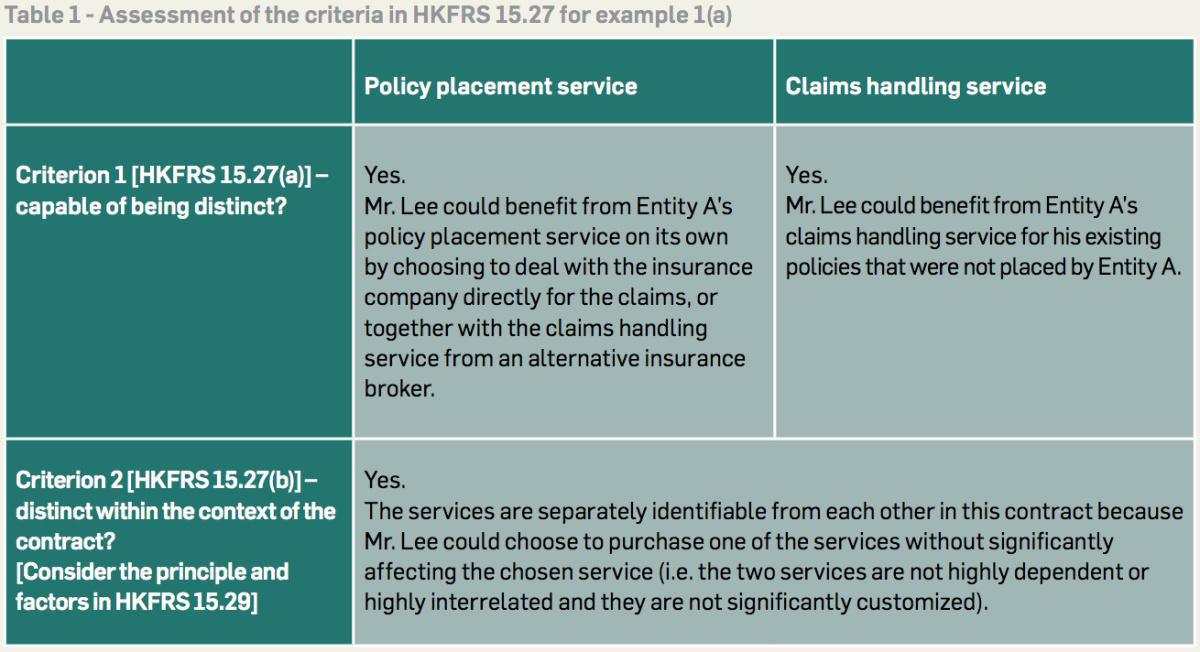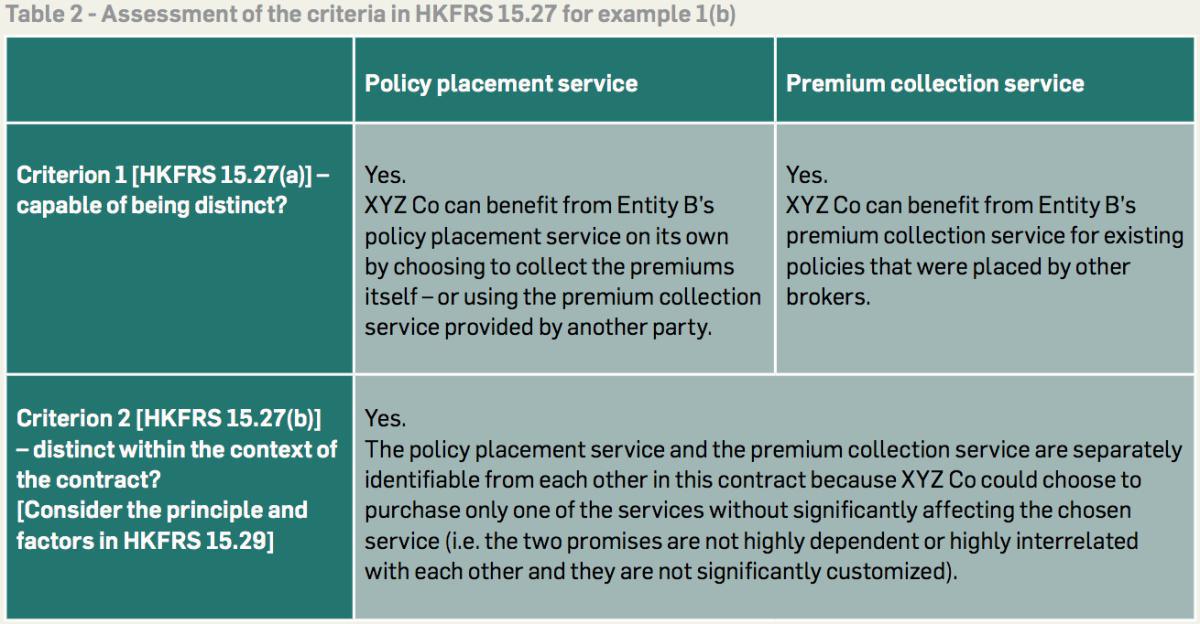Hong Kong Financial Reporting Standard (HKFRS) 15 Revenue from Contracts with Customers became effective on 1 January 2018. Insurance intermediaries will need to assess their contracts with customers to determine how HKFRS 15 affects the timing and amount of revenue recognized.
The core principle in HKFRS 15 is that an entity recognizes revenue to depict the transfer of promised goods or services to customers in an amount that reflects the consideration to which the entity expects to be entitled in exchange for those goods or services, by applying the following five steps:
- Identify the contract(s) with a customer.
- Identify the performance obligations in the contract.
- Determine the transaction price.
- Allocate the transaction price to the performance obligations in the contract.
- Recognize revenue when (or as) an entity satisfies es a performance obligation.
This article provides illustrative examples to help insurance intermediaries address some key issues that have arisen when applying steps 2 and 3 to typical client and agency agreements. Insurance intermediaries are insurance agents or insurance brokers. An insurance agent normally represents an insurance company and is authorized to sell the company’s products. An insurance broker normally represents policyholders and may have agreements with a number of insurance companies.
Identification of performance obligations
It is common for an insurance intermediary to provide multiple services to a customer, which might be bundled together in a single contract. For example, an insurance broker might provide a policyholder both a policy placement service and a claims handling service under a single agreement.
Insurance intermediaries should not assume that performance obligations under HKFRS 15 will be the same as the separately-identified service components under Hong Kong Accounting Standard (HKAS) 18 Revenue. HKFRS 15 introduces comprehensive guidance on identifying performance obligations, which could result in the services in the contract being unbundled even if this was not required previously (or vice versa).
An entity identifies as a performance obligation each promise to transfer to the customer either a good or service (or a bundle of goods or services) that is distinct, or a series of distinct goods or services that are substantially the same and that have the same pattern of transfer to the customer (HKFRS 15.22). Identifying performance obligations in a contract under HKFRS 15 requires judgement. HKFRS 15.27 states that a good or service promised to a customer is distinct if both of the following criteria are met:
(a) The customer can bene t from the good or service either on its own or together with other resources that are readily available to the customer (i.e. the good or service is capable of being distinct); and
(b) The entity’s promise to transfer the good or service to the customer is separately identifiable from other promises in the contract (i.e. the promise to transfer the good or service is distinct within the context of the contract).
Paragraphs HKFRS 15.28-29 provide further guidance on how to apply these criteria.
The following example illustrates how an insurance intermediary might evaluate a contract with a customer to identify the performance obligations under HKFRS 15.
Example 1: Promised services in a contract
a. Contract with a prospective policyholder
Entity A is an insurance broker. It provides policy placement and/or claims handling services to prospective and existing policyholders. It may provide either one or both of the services depending on the terms of the contracts.
Entity A enters into a client agreement with Mr. Lee, a prospective policyholder. The client agreement states that:
- Entity A will assist in sourcing the best coverage for Mr. Lee and arrange insurance cover on his behalf.
- Mr. Lee will make the nal decision on selecting the insurance policy.
- Entity A will be remunerated by a commission which is an agreed-upon percentage of the insurance premium, paid by Mr. Lee, quoted by the selected insurance company.
- Entity A will assist Mr. Lee in handling claims as and when he requests. Services include completing and submitting claim forms and collecting claim payments from the insurance company on his behalf. No additional fee is charged for the claims handling services in this contract.
- Entity A provides a number of insurance quotations for Mr. Lee to consider. Subsequently, Mr. Lee decides to purchase an insurance policy from XYZ Co.
Analysis
Entity A determines that Mr. Lee is its customer under HKFRS 15 as Mr. Lee has contracted with Entity A to obtain services that are outputs its ordinary activities.
Entity A identifies two promised services in the contract with Mr. Lee:
- Policy placement service – matching the insurance policy with the pre-identified criteria he set out.
- Claims handling service – completing and submitting claim forms.
Entity A then evaluates whether the two promised services are distinct, that is if they meet both of the criteria in HKFRS 15.27 (see Table 1).
Based on the analysis, Entity A concludes that the policy placement service and the claims handling service are two separate performance obligations in the contract.
b. Contract with the insurance company
Entity B is an insurance agent. It provides policy placement service and/or premium collection service to insurance companies. It may provide either one or both of the services to an insurance company depending on the terms of the contracts.
Entity B enters into an agency agreement with XYZ Co which states that:
- For all policies Entity B places on behalf of XYZ Co, Entity B will be responsible for verifying whether the information provided by the policyholder is valid and will explain to new policyholders the terms and other administrative procedures of the insurance policy on behalf of XYZ Co.
- Entity B will collect insurance premiums from policyholders and remit them to XYZ Co. Entity B will also follow up with policyholders for any overdue premiums such as sending settlement reminders to the policyholder.
- XYZ Co will accept any claim application that is submitted either by a policyholder directly or through Entity B.
Analysis
Entity B determines that the insurance company is its customer under HKFRS 15 as XYZ Co has contracted with Entity B to obtain services that are outputs of its ordinary activities in exchange for consideration.
Entity B identifies two promised services in the contract with XYZ Co:
- Policy placement service – sourcing potential policyholders, verifying their information, explaining the terms and other administrative procedures of the insurance contracts, and arranging premium payment to XYZ Co at contract inception.
- Premium collection service – collecting ongoing insurance premiums from policyholders on behalf of XYZ Co.
Similar to example 1(a), Entity B should evaluate whether the two promised services are distinct. Based on Table 2, Entity B concludes that the policy placement service and the premium collection service are two separate performance obligations in the contract with XYZ Co.
Implicit promises
A contract with a customer generally explicitly states the goods or services that an insurance intermediary promises to transfer to the customer. However, the performance obligations identified in a contract with a customer may not be limited to the goods or services that are explicitly stated in that contract. A contract may also include promises that are implied by an intermediary’s customary business practices, published policies or specific statements if, at the time of entering into the contract, those promises create a valid expectation of the customer that the insurance intermediary will transfer a good or service to the customer (HKFRS 15.24).
The following two examples illustrate how an insurance broker might identify implicit promises in a contract under HKFRS 15.
Example 2: Implicit promise of services
Entity X is an insurance broker. It has a historical practice of offering customers a free claims handling service.
ABC Co, a manufacturing company, would like to purchase comprehensive group medical insurance for its employees. Entity X arranged a briefing session for ABC Co to introduce its brokering services. Entity X indicated that it has provided a claims handling service for its customers in the past for no additional charge but did not explicitly promise ABC Co this service during negotiations. The final client agreement was for an insurance placement service and did not specify the provision of the claims handling service.
Analysis
On the basis of its customary business practice, Entity X determines at contract inception that it has made an implicit promise to provide a claims handling service to ABC Co. That is, in accordance with HKFRS 15.24, Entity X’s past practice of providing the claims handling service to other customers creates a valid expectation of ABC Co that it will receive a claims handling service. Consequently, Entity X identifies this implicit promise as performance obligation.
Example 3: No implicit promise of services
Using the facts above, but it is not the customary business practice of Entity X to provide a free claims handling service. Therefore, at the time of entering into the contract ABC Co does not have a valid expectation that Entity X will provide this service at no additional charge.
After entering into the client agreement to provide the policy placement service, ABC Co asks Entity X for assistance in ling a claim under its insurance policy. In order to maintain the relationship, Entity X agrees to assist in submitting the claim and seeking reimbursement from the insurance company on behalf of ABC Co for no additional consideration.
Analysis
The promise of handling claims is not included in the contract nor was it considered part of Entity X’s customary business practice at contract inception. Therefore when applying HKFRS 15.24, Entity X has not explicitly or implicitly promised to provide a claims handling service. Consequently, Entity X does not identify this as a performance obligation. However, Entity X should assess whether it would continue to help ABC Co in handling future claims and whether its actions create a present obligation to provide such a service. If so, this obligation may need to be accounted for under HKAS 37 Provisions, Contingent Liabilities and Contingent Assets.
Moreover, Entity X should consider whether this claim handling assistance has created a valid expectation of a complementary claims handling service to ABC Co and other potential customers when they negotiate new policies. If so, this would give rise to an implicit promise to provide the claims handling service and be a separate performance obligation.
Determination of the transaction price when there is variable consideration
Once an insurance intermediary identifies the performance obligations in a contract, the transaction price will need to be determined and allocated to those performance obligations.
In determining the transaction price, an insurance intermediary considers the effect of variable consideration. In some cases, the consideration may be variable because it is contingent on the outcome of future events, such as policy cancellations, lapses or renewals, volume of business or claims experience.
Under HKAS 18, insurance intermediaries often deferred recognition of variable consideration until revenue was reliably measurable, for example when the uncertainty was removed or when payment was received. Under HKFRS 15, the amount of variable consideration is estimated using either the expected value (the sum of probability-weighted amounts) or the most likely amount – depending on which method the entity expects to better predict the amount of consideration to which it will be entitled (HKFRS 15.53). An insurance intermediary should update its estimated transaction price, including the estimate of the variable consideration at the end of each reporting period for any changes in circumstances (HKFRS 15.59).
Variable consideration is only included in the estimated transaction price if it is highly probable that a significant reversal in the cumulative revenue recognized will not occur in future periods (HKFRS 15.56). In applying this requirement, insurance intermediaries should consider both the likelihood and the magnitude of the revenue reversal. HKFRS 15.57 provides examples of factors that could increase the likelihood or the magnitude of a revenue reversal.
The example below illustrates how an insurance agent might estimate the variable consideration, including assessing whether the estimate is constrained.
Example 4: Commissions with clawback provisions
Entity Y, an insurance agent, has a contract with an insurance company. The insurance company pays Entity Y commission of 10 percent of the premiums on a medical insurance policy for every successfully placed policy. Commission is due when Entity Y issues the policyholder the premiums due notice. Entity Y is required to return the full amount of commission to the insurance company if the insurance policy is cancelled within six months from the date of issuing the notice.
For internal management purposes Entity Y allocates policyholders into one of three categories (A, B or C) based on factors including their age group, risk pro le and occupation.
Entity Y successfully placed 100 medical insurance contracts on 15 December 20X6. All of these contracts are made with policyholders in category B. The total commissions are HK$200,000. The existence of clawback provisions causes the commissions to be variable. Entity Y should assess the amount of variable commission to be included in the transaction price.
Analysis
Case A – Estimate of variable consideration (with predictive information)
Entity Y selects the expected value method because it has a large number of contracts with similar characteristics. In order to estimate the expected value, Entity Y considers historical experience for similar types of medical insurance policies and the category to which the policyholder is allocated to derive the probability of clawback. Based on observable historical data and experience, Entity Y estimates that 2 percent of category B newly written medical insurance policies will be cancelled within six months.
Entity Y estimates the amount of variable consideration to be HK$196,000 (i.e. HK$200,000 x 98 percent). Entity Y then considers the factors in HKFRS 15.57 and assesses whether there is any constraint on the estimate i.e. whether it is highly probable that a significant reversal in the amount of the cumulative commission revenue recognized will occur by the end of the clawback period. Entity Y has significant experience in estimating policy cancellations for this category, and the cancellation rate was not significantly higher than 2 percent in recent years. In addition, the uncertainty associated with the variable consideration will be resolved within a relatively short timeframe (six months). Entity Y concludes that it is highly probable that a significant reversal of the commission revenue recognized will therefore not occur by the end of the clawback period and recognizes HK$196,000 as commission revenue.
Case B – Estimate of variable consideration (without predictive information)
Entity Y has limited experience in estimating policy cancellations for policyholders in category B and prior experience is considered to have little predictive value of future cancellations. Observable data indicates that the historical cancellation rate has ranged from 4-8 percent. Current market information (e.g. business confidence) indicates that there is a probability that 0-20 percent of category B newly written medical insurance policies will be cancelled within six months.
Using the expected value method, Entity Y estimates the amount of variable consideration to be HK$188,000 (using a 6 percent cancellation rate). However the market data indicates that 0-20 percent of the newly written medical insurance policies for policyholders in category B will be cancelled within six months. Entity Y cannot conclude that it is highly probable that some of the commission revenue of HK$188,000 would not be subject to clawback in the future. Consequently, Entity Y includes only HK$160,000 (HK$200,000 x 80 percent) as commission revenue considering it is highly probable that a significant reversal of revenue will not occur by the end of the clawback period.
This article is written by the Standard Setting Department in consultation with experts from accounting rms and the insurance industry. It is intended for general reference only and has no authority. The Institute and the staff of the Institute do not accept any responsibility or liability in respect of the article and any consequences that may arise from any person acting or refraining from action as a result of any materials in the article. The department previously published an article in June 2017 on the accounting of premiums receivable from policyholders by insurance brokers.


















